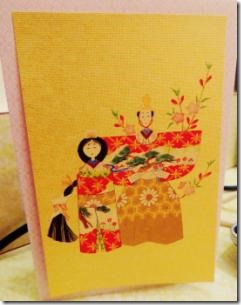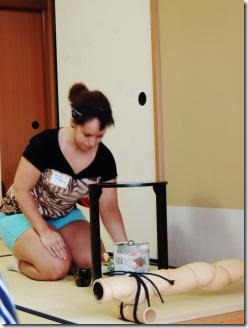Old Country Club Road NW
Happy Pi Day (Jane sent me the greetings and Randal explained it to me!)
So, now that we know I don’t do math or any kind…… Saturday I took the day off from LeRoy and he and Randal went to Puppy Play at Hanging Rock Veterinarians. For two hours LeRoy ran away from all of the other dogs either hiding behind Randal or visiting the other dog owners. So Yay he likes people!!! The last 5 minutes or so apparently LeRoy discovered the other dogs weren’t out to eat him so nosed a few of them. LeRoy likes his dog interactions to be one at a time and then it’s fine. We’ll take him back to Puppy Play which they do every other week and see if things improve. But being among a gang of dogs just might not be his thing. LeRoy definitely loves Stoker next door. And now he’s over his fear of leaving the yard so goes with me on my two mile morning walk. Today we had to learn that the huge “one arm bandits” were only coming for the trash and not him. By the third time they passed us, we were okay. What I did on Saturday was attend a lovely Tea Ceremony at Washington and Lee University in Lexington; quiet and contemplative unlike “puppy play.”
Ru
Terra Firma which is getting more Firma is the weather improves.
Doll Festival/Girls Day
I can’t remember which came first, Chimaki’s card telling about Doll Festival/Girls Day or Jane’s invitation to attend a Tea Ceremony in celebration of Doll Festival/Girls Day. But both made it possible for me to take part in this lovely tradition in Japanese culture. Back in the mid-1980s on a visit to Japan (as well as a visit with Chimaki) with my friend Martha, her brother Bob and her neighbor Mike; we were able to observe a performance of a Tea Ceremony in the Ginza area. And then years later, I’m sure thanks to my friend Becky, I participated in a Tea Ceremony at Roanoke College.
“March 3 is Hina Matsuri (Doll Festival or Girls’ Festival), when people pray for the happiness and healthy growth of girls. Families with young daughters mark this day by setting up a display of dolls inside the house. They offer rice crackers and other food to the dolls…. The practice of displaying these dolls on the third day of the third month on the traditional Japanese calendar began during the Edo period (1603-1868). It started as a way of warding off evil spirits, with the dolls acting as a charm. Even today, people in some parts of the country release paper dolls into rivers after the festival, praying that the dolls take people’s place in carrying away sickness and bad fortune.
Most families take their beautiful collection of dolls out of the closet around mid-February and put it away again as soon as Hina Matsuri is over. This is because of an old superstition that families that are slow in putting back the dolls have trouble marrying off their daughters.”
http://web-japan.org/kidsweb/explore/calendar/march/hinamatsuri.html
Chimaki’s card showing the Empress and Emperor Doll. Notice the Emperor is on the right looking at the viewer. At the Tea Ceremony we were told that the positions of the Emperor and Empress were not fixed but depended on if one followed the Tokyo or Kyoto Tradition.
Emperor and Empress Doll Positions
Old and Modern Styles in Kyoto
Kyoto Shimbun 2009.2.23 News
The day of “Hina-matsuri,” or Doll Festival, is March 3. In Kyoto, there are different ways to display “Mebina,” or the empress doll, and “Obina,” or the emperor doll, depending on the hina doll shop. Long-established doll shops are more likely to display the empress doll on the observers’ left and the emperor doll on the right, whereas newer national chain stores tend to display them in the reverse of that. It is said that a mixture of both displays is a phenomenon peculiar to Kyoto.
The Hashimoto doll shop in Shimogyo Ward, established in the late Edo Period, displays the empress doll on the observers’ left. The doll shop owner explained, “Most long-established shops set up dolls like this.” On the other hand, a shopping center that was opened five years ago in Ukyo Ward displays the empress doll on the right. The person in charge said, “This is the way they are commonly displayed in our nationwide chain of stores.”
Which is the proper way? The Japan Dolls Association in Tokyo explained, “Either way is acceptable.” However, that does not mean there is no proper display. In general, hina dolls are called “Dairi-bina,” or a pair of dolls modeled after the Emperor and Empress, based on the Imperial Court culture. Prior to the Taisho Period, the Obina was displayed on the observers’ right all across the country. Furthermore, it has been said that Obina should be displayed on the east side for the sun rising, when dolls are placed at the Kyoto Imperial Palace facing the south, which is the direction of its front gate.
However, the Emperor stood to the right, or the observers’ left, of the Empress in the Showa Enthronement Ceremony in 1928, and also, the Emperor, who was dressed in Western style, stood on observers’ left in a picture. That seems to be why the doll industry in Tokyo has interchanged the position of the emperor and empress dolls from the pre-war period. That change has spread across the country. However, according to Kyo-ningyo Commerce-and-Industry Cooperative, long-established shops in Kyoto alone have voluntarily honored “Yusoku-kojitsu,” or traditional court and samurai rules of ceremony and etiquette.
The Japan Doll Association calls the way of displaying the empress doll on observers’ left in long-established Kyoto shops “Old Style,” and the opposite way “Modern Style.”
Only the Kyoto store in Shimogyo Ward, of the 18 Takashimaya department stores located around Japan displays the dolls in both the old and modern styles. Dolls made in Kyoto are displayed in the old style. This even applies to sweets modeled after hina dolls; although most of the cake decoration and package designs sold at department stores are modern style, most long-established Japanese-style confectionery stores in Kyoto maintain the old style.”
http://www.kyoto-np.co.jp/kp/topics/eng/2009feb/02-23.html
Jane’s friend Tam (who you met when we all visited the Japanese Calligraphy exhibit at Washington & Lee) is again responsible for our invitations to the Tea Ceremony at Washington & Lee University which has a lovely Tea Room on campus enhancing the Japanese Studies Program.
Elizabeth, a librarian at W&L and her mom Tamara, a retired school librarian. Both Tam and Jane still work with Virginia Reads and school programs and getting books and kids together.
Chanoyu Tea Society at W&L
A Student Organization
Tea Society is a student organization made up students at Washington and Lee University who are interested in the study of chanoyu, the traditional art of the Japanese tea ceremony. This group performs numerous tea demonstrations for on-campus and community organizations. Please contact Professor Ikeda (ikedaj@wlu.edu) if you are a student interested in joining or if you are interested in scheduling a demonstration for your group.
Chanoyu Tea Society Slideshow which shows more than my limited few photos the tea room and the various aspects connected to the tea ceremony.
http://www.kyoto-np.co.jp/kp/topics/eng/2009feb/02-23.html http://www.wlu.edu/japanese-tearoom/chanoyu-tea-society-at-wandl
Senshin’an
Gift of a Tea Room Name
The Washington and Lee University Tea Room in the Watson Pavilion received the name “Senshin’an”(洗心庵)or “Clearing-the-Mind Abode” from Sen Genshitsu, the 15th-generation Grand Master of the Urasenke Tradition of Tea.
. http://www.wlu.edu/japanese-tearoom/the-senshinan-tearoom-at-wandl/tea-room-architecture discusses the architecture of the Tea Room which is as important as the actual ceremony. Everything about the room’s design, the specifically selected scroll and decorative piece all work to help the host and guests focus only on the moment and the tea ceremony.
Professor Janet Ikeda and students Stephanie Hernandez and Jannelle (The letters on Jannelle’s name tag were still too small for my zoom to allow me to read.)
Stephanie explained the Tea Ceremony as we watched it performed by Jannelle, acting as host.
Tea Room Empress and Emperor Dolls
Decorative scroll and more dolls to set the “topic” for contemplation.
Scrolls and additional decorations are changed according to the season or occasion to encourage thoughts on a specific topic. Apparently the decorations on tea cups may mirror the topic.
The foamy, warm green tea is an acquired taste I think. Boiling hot Brit Rail tea is my preference. But the sweets, served before the tea, were lovely to look at and tasted very good!
Tam, Janet and Jane outside the Watson Pavilion built to house the Tea Room.
http://www.kyoto-shimazu.com/en/History_of_Yusoku_Hina_Ningyo_Dolls.html detailed history of the festivals.
https://www.youtube.com/watch?v=K6_KC3OuZEk tea ceremony explained through dialog
And in case you were wondering about Boys Day……
The Japanese Boys’ Festival called “Tango no Sekku”, plus a Song for the Holiday called “Koinobori”
May 3rd, 2006
Tango no Sekku is celebrated on May 5th. In Japan, this day is called Boys’ Festival. It’s been celebrated for over a millennium. Originally it was celebrated in the houses of warriors. It celebrated boys’ courage and determination. Many of the symbols of this day are about having the character of a warrior. Eventually this day became important to all households in Japan with boys.
After WWII, Boys’ Day became toned down. This holiday officially became known as Children’s Day or Kodomo no hi. It’s supposed to be a day to celebrate the health and happiness of all children. But many people still see it as Boys’ Festival.
Large carp windsocks, called koinobori, are displayed outside houses of families with boys. There’s one windsock for each boy in the house. The largest windsock is for the oldest son of the house.
http://www.mamalisa.com/blog/the-japanese-boys-festival-is-called-tango-no-sekku/











